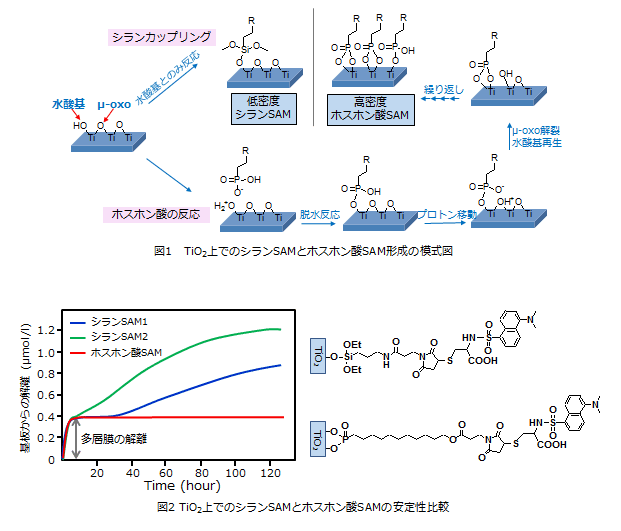M-EG3-UPA

Self Assembled Monolayer(SAM)研究用試薬
-
製品コードM457 M-EG3-UPA
-
CAS番号-
-
化学名11-{2-[2-(2-Methoxyethoxy)ethoxy]ethoxy}undecylphosphonic acid
-
分子式・分子量C18H39O7P=398.47
| 容 量 | メーカー希望 小売価格 |
富士フイルム 和光純薬 |
|---|---|---|
| 10 mg | ¥22,100 | 343-91611 |
性質
ホスホン酸誘導体は、Al2O31,2)、TiO23-7)、ZrO23,4)、シリコン酸化膜(SiO2)8-11)、マイカ12)、ステンレス(SS316L)13)、ニチノール14,15)、ヒドロキシアパタイト16)、ZnO17)、ITO18)等の金属酸化物上に結合して自己組織化単分子膜(SAM)を形成することから、有機デバイスやバイオセンサなど様々な用途で応用され始めている。
金属酸化物の表面処理に古くから用いられているシランカップリング剤と比べ、ホスホン酸誘導体は試薬が安定で、形成されるSAMが高密度という利点を有している。シランカップリング剤は活性が高く、水分があると試薬自身が重合して次第に溶液は白濁する。これに対し、ホスホン酸誘導体は非常に安定な化合物であり、試薬が重合することはない。また、シランカップリング剤が基板上に存在する水酸基(OH)としか反応できないのに対し、ホスホン酸はプロトン(H+)を基板に供給して水酸基を再生することで、高密度なSAMが形成されるというモデルが提唱されている(図1)。
ホスホン酸SAMの安定性は基板の金属酸化物の種類に依存し、Al2O3やTiO2基板上では比較的安定なSAMが形成されるが、SiO2基板上のSAMは加水分解を受け易い。特にTiO2基板上のホスホン酸SAMはシランSAMに比べ加水分解されにくいことが報告されている。SilvermanらはTiO2上に形成されたSAMの末端に蛍光基を導入し、蛍光基の基板からの脱離を評価することでSAMの安定性を議論しており6)、ホスホン酸のSAMはpH7.5 の水中に室温、7日浸漬しても全く蛍光基が脱離しないのに対し、APTS(アミノプロピルトリエトキシシラン)のSAMでは経時的な蛍光基の脱離が観測されている(図2)。
M-EG3-UPAは末端にオリゴエチレングリコールを有するホスホン酸誘導体である。タンパク質等の非特異吸着の防止や、親水性の向上、微粒子の分散などでの応用が期待される。
*ホスホン酸SAM作製法に関しては下記資料に記載しているので、ご参照頂きたい。
http://www.dojindo.co.jp/technical/pdf/sam_phosphon.pdf
技術情報
注意事項
・本製品を粉末の状態で取り出し使用する場合、性状の性質上、静電気等の要因で容器内に付着し、取り出しにくい場合があります。
・容器内に付着し、取り出せなかった粉末に関しては、使用する溶媒を容器に入れ、溶かし出して使用してください。
溶解例
10 mmol/l 以上: Water, Methyl alcohol, Ethyl alcohol, Tetrahydrofuran, Xylene, Dimethylsulfoxide
参考文献
参考文献
1) T. Hauffman, O. Blajiev, J. Snauwaert, C. van Haesendonck, A. Hubin, H. Terryn, "Study of the self-assembling of n-octylphosphonic acid layers on aluminum oxide", Langmuir, 2008, 24 (23), 13450.
2) P. Thissen, M. Valtiner, G. Grundmeier, "Stability of Phosphonic Acid Self-Assembled Monolayers on Amorphous and Single-Crystalline Aluminum Oxide Surfaces in Aqueous Solution", Langmuir, 2010, 26 (1), 156.
3) W. Gao, L. Reven, "Solid-state NMR-studies of self-assembled monolayers", Langmuir, 1995, 11 (6), 1860.
4) S. Marcinko, A. Y. Fadeev, "Hydrolytic Stability of Organic Monolayers Supported on TiO2 and ZrO2", Langmuir, 2004, 20 (6), 2270.
5) J. Schwartz, M. J. Avaltroni, M. P. Danahy, B. M. Silverman, E. L. Hanson, J. E. Schwarzbauer, K. S. Midwood, E. S. Gawalt, " Cell attachment and spreading on metal implant materials", J. Mat. Sci. Eng. C, 2003, 23, 395.
6) B. M. Silverman, K. A. Wieghaus, J. Schwartz, "Comparative properties of siloxane vs phosphonate monolayers on a key titanium alloy", Langmuir, 2005, 21 (1), 225.
7) N. Adden, L. J. Gamble, D. G. Castner, A. Hoffmann, G. Gross, H. Menzel, "Phosphonic Acid Monolayers for Binding of Bioactive Molecules to Titanium Surfaces", Langmuir, 2006, 22, 8197.
8) E. L. Hanson, J. Schwartz, B. Nickel, N. Koch, M. F. Danisman, "Bonding self-assembled, compact organophosphonate monolayers to the native oxide surface of silicon", J. Am. Chem. Soc. 2003, 125 (51), 16074.
9) M. Dubey, T. Weidner, L. J. Gamble, D. G. Castner, "Structure and Order of Phosphonic Acid-Based Self-Assembled Monolayers on Si(100)", Langmuir, 2010, 26 (18), 14747.
10) A. Vega, P. Thissen, Y. J. Chabal, "Environment-Controlled Tethering by Aggregation and Growth of Phosphonic Acid Monolayers on Silicon Oxide", Langmuir, 2012, 28, 8046.
11) P. Thissen, A. Vega, T. Peixoto, Y. J. Chabal, "Controlled, Low-Coverage Metal Oxide Activation of Silicon for Organic Functionalization: Unraveling the Phosphonate Bond", Langmuir, 2012, 28 (50), 17494.
12) J. T. Woodward, A. Ulman, D. K. Schwartz, "Self-assembled monolayer growth of octadecylphosphonic acid on mica", Langmuir, 1996, 12 (15), 3626.
13) A. Raman, M. Dubey, I. Gouzman and E. S. Gawalt, "Formation of self-assembled monolayers of alkylphosphonic acid on the netive oxide surface of SS316L", Langmuir, 2006, 22, 6469.
14) G. Zorn, R. Adadi, R. Brener, V. A. Yakovlev,| I. Gotman, E. Y. Gutmanas, C. N. Sukenik, "Tailoring the Surface of NiTi Alloy Using PIRAC Nitriding Followed by Anodization and Phosphonate Monolayer Deposition", Chem. Mater. 2008, 20, 5368.
15) R. Quinones and E. S. Gawalt, "Polystyrene formation on monolayer-modified nitinol effectively controls corrosion", Langmuir, 2008, 24, 10858.
16) S. C. D’Andrea and Al. Y. Fadeev, "Covalent surface modification of calcium hydroxyapatite using n-alkyl- and n-fluoroalkylphosphonic acids", Langmuir, 2003, 19, 7904.
17) B. Zhang, T. Kong, W. Xu, R. Su, Y. Gao and G. Cheng, "Surface functionalization of zinc oxide by carboxyalkylphosphonic acid self-assembled monolayers", Langmuir, 2010, 26(6), 4514.
18) A. Sharma, B. Kippelen, P. J. Hotchkiss and S. R. Marder, "Stabilization of the work function of indium tin oxide using organic surface modifiers in organic light-emitting diodes", Appl. Phys. Lett., 2008, 93, 163308.














